Validation of the Hurricane Imaging Radiometer Forward Radiative Transfer Model for a Convective Rain Event
Abstract
:1. Introduction
1.1. HIRAD Hurricane Surveillance
1.2. Rain Impact on Retrievals
1.3. Tampa Bay Rain Experiment
2. Remote Sensor Description
2.1. HIRAD Instrument
2.2. NEXRAD Description
3. Rain Rate Products
3.1. NEXRAD Z-R
3.2. 3D Instantaneous Rain Volume
3.3. NEXRAD Morphing
3.4. Cross-Track Scan Rain Rate Vertical Profile
4. HIRAD RTM
5. HIRAD Brightness Temperature Measurements
5.1. Radiometric Calibration
5.2. Tb Measurements for Flight Pass-2
6. Results
6.1. Forward RTM Results
6.2. Comparison of HIRAD Measured and Modeled Tb Images
7. Discussion
8. Conclusions
Author Contributions
Funding
Conflicts of Interest
References
- Amarin, R.A.; Jones, W.L.; El-Nimri, S.F.; Johnson, J.W.; Ruf, C.S.; Miller, T.L.; Uhlhorn, E. Hurricane Wind Speed Measurements in Rainy Conditions using the Airborne Hurricane Imaging Radiometer (HIRAD). IEEE Trans. GeoSci. Remote Sens. 2012, 50, 180–192. [Google Scholar] [CrossRef]
- Uhlhorn, E.W.; Black, P.G.; Franklin, J.L.; Goldstein, A.S. Hurricane Surface Wind Measurements from an Operational Stepped Frequency Microwave Radiometer. Mon. Weather Rev. 2007, 135, 3070–3085. [Google Scholar] [CrossRef]
- Jones, W.L.; Zec, J.; Johnson, J.W.; Ruf, C.; Bailey, M.C. A Feasibility Study for a Wide-Swath, High Resolution, Airborne Microwave Radiometer for Operational Hurricane Measurements. In Proceedings of the IEEE IGARSS 2002, Toronto, ON, Canada, 24–28 June 2002. [Google Scholar]
- Johnson, J.W.; Amarin, R.A.; El-Nimri, S.F.; Jones, W.L. A Wide-Swath, Hurricane Imaging Radiometer for Airborne Operational Measurements. In Proceedings of the IEEE IGARSS 2006, Denver, CO, USA, 28 August–1 September 2006. [Google Scholar]
- Amarin, R. Hurricane Wind Speed and Rain Rate Measurements Using the Airborne Hurricane Imaging Radiometer (HIRAD). Ph.D. Thesis, University of Central Florida, Orlando, FL, USA, 2010. [Google Scholar]
- Jacob, M.M.; Salemirad, M.; Jones, W.L.; Biswas, S.; Cecil, D. Validation of Rain Rate Retrievals for the Airborne Hurricane Imaging Radiometer (HIRAD). In Proceedings of the IEEE IGARSS 2015, Milan, Italy, 27–31 July 2015. [Google Scholar]
- Braun, S.A.; Newman, P.A.; Heymsfield, G.M. NASA’s Hurricane and Severe Storm Sentinel (HS3) Investigation. Bull. Am. Meteor. Soc. 2016, 97, 2085–2102. [Google Scholar] [CrossRef]
- Ruf, C.S.; Swift, C.T.; Tanner, A.B.; Le Vine, D.M. Interferometric synthetic aperture microwave radiometry for the remote sensing of the earth. IEEE Trans. Geosci. Remote Sens. 1988, 26, 597–611. [Google Scholar] [CrossRef]
- Bailey, M.C.; Amarin, R.A.; Johnson, J.; Nelson, P.; James, M.; Simmons, D.; Ruf, C.; Jones, W.L.; Gong, X. Multi-Frequency Synthetic Thinned Array Antenna for the Hurricane Imaging Radiometer. IEEE AP-S Trans. Antennas Propag. 2010, 58, 2562–2570. [Google Scholar] [CrossRef]
- Federal Meteorological Handbook No. 11: Doppler Radar Meteorological Observations, Part B: Doppler Radar Theory and Meteorology; Report FCM-H11B-1990, Interim Version One; Office of the Federal Coordinator for Meteorological Services and Supporting Research: Rockville, MD, USA, 1990; p. 228.
- Fulton, R.A.; Breidenbach, J.P.; Seo, D.J.; Miller, D.A.; O’Bannon, T. The WSR-88D rainfall algorithm. Weather Forecast. 1998, 13, 377–395. [Google Scholar] [CrossRef]
- Schneider, L.; Jones, W.L. Analysis of spatially and temporally disjoint precipitation datasets to estimate the 3D distribution of rain. In Proceedings of the IEEE IGARSS 2017, Fort Worth, TX, USA, 23–28 July 2017. [Google Scholar]
- El-Nimri, S. Development of An Improved Microwave Ocean Surface Emissivity Radiative Transfer Model. Ph.D. Thesis, University of Central Florida, Orlando, FL, USA, 2010. [Google Scholar]
- El-Nimri, S.F.; Jones, W.L.; Uhlhorn, E.; Ruf, C.; Johnson, J.; Peter, B. An Improved C-Band Ocean Surface Emissivity Model at Hurricane-Force Wind Speeds over a Wide Range of Earth Incidence Angles. IEEE Geosci. Remote Sens. Lett. 2010, 7, 641–645. [Google Scholar] [CrossRef]
- Klotz, B.W.; Uhlhorn, E.W. Improved Stepped Frequency Microwave Radiometer Tropical Cyclone Surface Winds in Heavy Precipitation. J. Atmos. Ocean. Technol. 2014, 31, 2392–2408. [Google Scholar] [CrossRef]
- Ruf, C.; Roberts, J.B.; Biswas, S.; James, M.; Miller, T. Calibration and image reconstruction for The Hurricane Imaging Radiometer (HIRAD). In Proceedings of the IEEE IGARSS 2012, Munich, Germany, 22–27 July 2012. [Google Scholar]
- Alasgah, A.; Jacob, M.; Jones, W.L. Removal of Artifacts from Hurricane Imaging Radiometer Tb Images. In Proceedings of the IEEE 2017 SoutheastCon, Concord, NC, USA, 3 March–2 April 2012. [Google Scholar]
- National Centers for Environmental Prediction (NCEP); Final (FNL). Operational Global Analyses. Available online: http://rda.ucar.edu/datasets/ds083.2 (accessed on 30 April 2019).
- Ulaby, F.; Long, D. Microwave Radar and Radiometric Remote Sensing; Univ. Mich Press: Ann Arbor, MI, USA, 2014; pp. 236–239. ISBN 978-0-472-11935-6. [Google Scholar]
- Sahawneh, S.; Jones, L.; Biswas, S.; Cecil, D. HIRAD Brightness Temperature Image Geolocation Validation. IEEE Geosci. Remote Sens. Lett. 2017, 14, 1908–1912. [Google Scholar] [CrossRef]








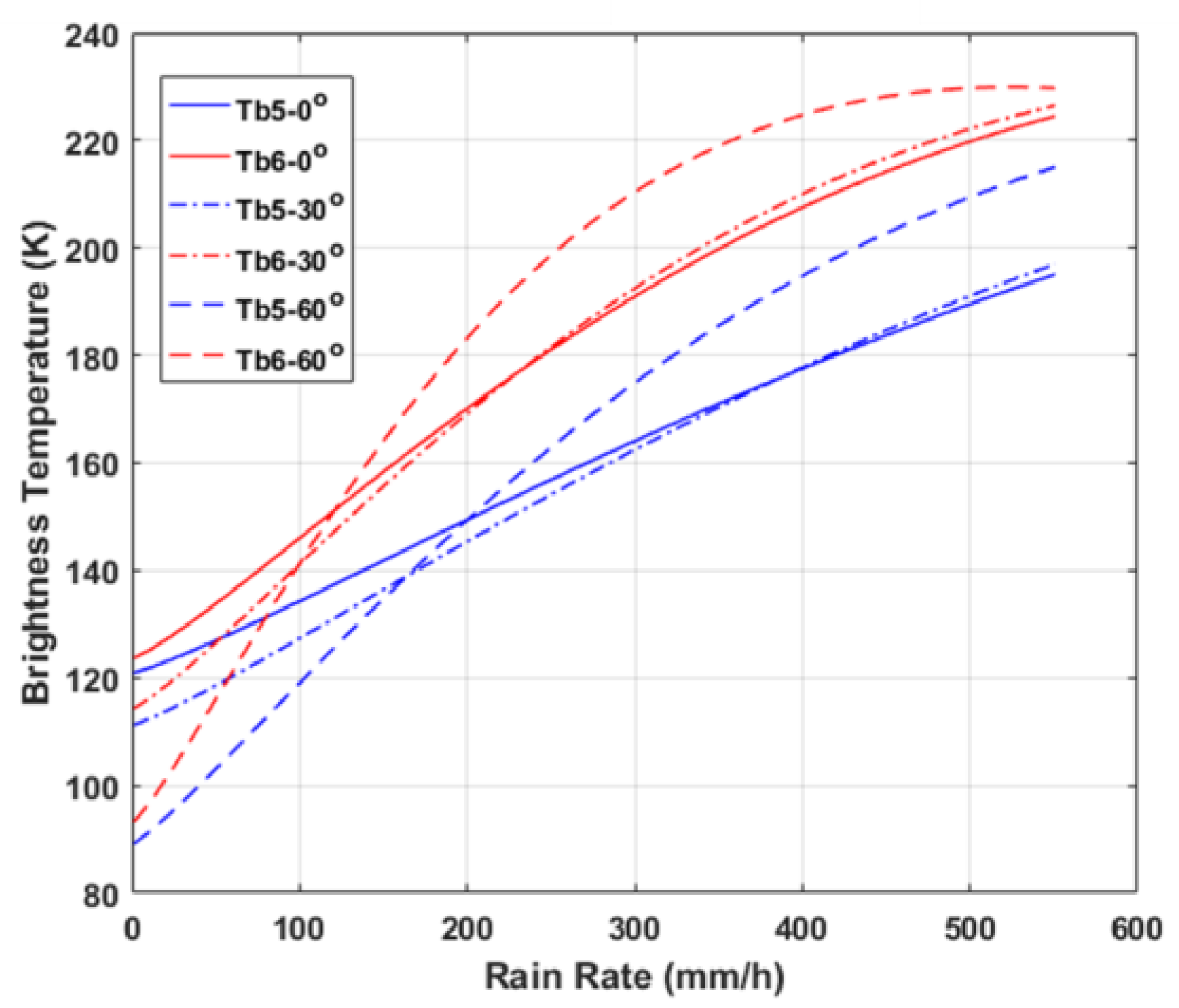










| (a) | |||
| Region Pass-2 | Model Tb Dynamic Range Max/Min, K | Measurement—Model_APC Mean/STD, K | Regression Slope/Offset |
| All points scans (1:661) | 150/90 | 1.60/2.76 | 0.90/1.39 |
| Clear-sky scans (230:530) | 130/90 | 0.25/1.06 | 0.98/2.14 |
| Rain–1 scans (50:170) | 150/100 | 3.67/3.52 | 0.90/8.97 |
| Rain–2 scans (550:620) | 160/100 | 4.04/3.44 | 0.91/7.00 |
| Tb_atmos (R-1 and R-2) | 60/8 | 7.25/1.75 | 0.77/7.60 |
| (b) | |||
| Region Pass-2 | Model Tb Dynamic Range Max/Min, K | Measurement—Model_APC Mean/STD, K | Regression Slope/Offset |
| All points scans (1:661) | 150/90 | 2.22/4.39 | 0.86/4.5 |
| Clear-sky scans (230:530) | 130/90 | 0.49/2.50 | 0.88/13.9 |
| Rain–1 scans (50:170) | 100/170 | 4.52/5.27 | 0.92/5.34 |
| Rain–2 scans (550:620) | 100/190 | 6.43/5.72 | 1.06/-14.0 |
| Tb_atmos (R1 and R2) | 80/8 | 3.83/2.92 | 0.78/9.50 |
© 2019 by the authors. Licensee MDPI, Basel, Switzerland. This article is an open access article distributed under the terms and conditions of the Creative Commons Attribution (CC BY) license (http://creativecommons.org/licenses/by/4.0/).
Share and Cite
Alasgah, A.; Jacob, M.; Jones, L.; Schneider, L. Validation of the Hurricane Imaging Radiometer Forward Radiative Transfer Model for a Convective Rain Event. Remote Sens. 2019, 11, 2650. https://doi.org/10.3390/rs11222650
Alasgah A, Jacob M, Jones L, Schneider L. Validation of the Hurricane Imaging Radiometer Forward Radiative Transfer Model for a Convective Rain Event. Remote Sensing. 2019; 11(22):2650. https://doi.org/10.3390/rs11222650
Chicago/Turabian StyleAlasgah, Abdusalam, Maria Jacob, Linwood Jones, and Larry Schneider. 2019. "Validation of the Hurricane Imaging Radiometer Forward Radiative Transfer Model for a Convective Rain Event" Remote Sensing 11, no. 22: 2650. https://doi.org/10.3390/rs11222650
APA StyleAlasgah, A., Jacob, M., Jones, L., & Schneider, L. (2019). Validation of the Hurricane Imaging Radiometer Forward Radiative Transfer Model for a Convective Rain Event. Remote Sensing, 11(22), 2650. https://doi.org/10.3390/rs11222650






